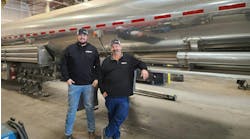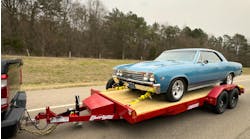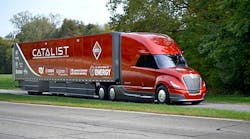In a perfect world, the aero-ideal tractor-trailer would be a seamless combination that creates barely a ripple in the Computational Fluid Dynamics modeling pond it emerged from.
Think of the DOE’s SuperTruck program and its bullet-shaped big rigs, or the Shell StarShip. Think of how fleets would love to improve their fuel efficiency by 30, 40 or 50 percent. Putting the tractor with a matched trailer is called “intentional pairing,” and intentional pairing plays a big part in achieving those theoretical gains.
Now think of the messy world of freight movement where the ideal vehicle is simply the one that can deliver the load exactly on schedule and on budget. Think of a drop-and-hook operation, and the trailer pool needed to support it.
So how will intentional pairing work in the real world? Alas, according to an analysis recently published by the North American Council on Freight Efficiency, it won’t—at least not broadly.
But that doesn’t mean truck OEMs, trailer manufacturers, and aero-device designers should abandon their pursuit of the ideal, NACFE Executive Director Mike Roeth explained to me when we discussed the findings.
“Over the years, I’d be sitting in meetings, or on SuperTruck reviews,” he began, “where people—usually engineers—will say, ‘if we can just keep a tractor and trailer together, we could design it so it would fit better: more aerodynamic, with better fuel economy. Wouldn’t that be great?’
“And I usually sit there and think, yeah—that’s never going to happen. And it shouldn’t happen.”
There’s the lab, you see, and then there’s the loading dock. Early in NACFE’s Run on Less program, “a best-of-the best roadshow” to showcase advancements in freight efficiency, Roeth’s team had put promotional graphics on the featured tractor-trailer combination. As he soon discovered, even on a dedicated regional route with the same truck and driver, the Run on Less trailer might come along for one trip out of five. Most of the time it was being used elsewhere.
Likewise, if a short-haul load needs to move and a trailer with all the aero bells and whistles is the only one available, out it goes—even if that means putting a less-than-ideal trailer on the cross-country run that comes across the dispatch desk later.
“To keep tractors rolling, to keep drivers moving, it’s drop and hook and move on,” Roeth said.
And NACFE did the math—nearly 90 pages worth of facts and figures to try to make sense of all the variables that go into getting loads moved on North American roads. The bottom line: “While intentional pairing is feasible, it is not realistic given the realities of todays’ trucking industry.”
While intentionally pairing by model type would provide the greatest opportunity for on-highway MPG gains, the study adds, pairing a SuperTruck-style trailer to an older model year tractor would still result in MPG benefits, as would pairing a SuperTruck tractor to less aerodynamic trailers.
The NACFE report also points out that while pairing assets currently is rare, the growth in equipping trailers with telematics systems (see the story on connected trailers - Smart trailer outlook - The advantages are many, but so are the challenges), combined with the deployment of GPS-tracked tractors, will enable fleets to implement a variety of asset optimization algorithms—including trailer matching.
Yet there are opportunities for intentional pairing. The study cites beverage hauling, with loads that tend to weigh-out to the maximum.
“If you’re lightweighting both the tractor and trailer and pair those intentionally, and if you put them on routes where they are completely full all the time, that’ll allow you to haul a few more cases of soda or beer or Gatorade—that’s a really good thing,” Roeth said. “So there are some unique instances where pairing is a good thing, and it can make you money. But, all in all, it probably hurts our overall freight efficiency by trying to keep tractors and trailers together.”
To further complicate matters, several known unknowns will significantly impact trucking operations in the coming decade: e-commerce demands on the supply chain, truck electrification, and autonomous driving, the study notes.
But waiting to see what will develop is no reason for fleets to defer investing in the latest trucks and trailers.
“Fleets are already improving their fuel economy through tires, tire pressure systems, aerodynamic devices on the trailer,” Roeth said. “All that is important to do, and completely independent of whether you try to keep the trailer with a tractor.
“Think about basic change management. If I’m worried about making a mistake with the new technology, or because so much changes, then I just don’t do anything. That’s a scary place to be, because other fleets are doing things to get better.”










